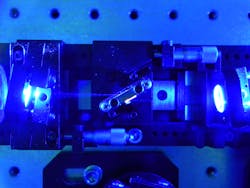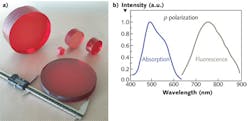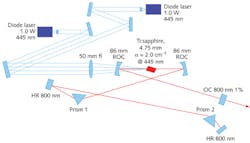CHRISTOPHER WOOD, STERLING BACKUS, JEFF SQUIER, and CHARLES DURFEE
Much emphasis has recently been placed on new gain materials for pulsed lasers, especially fiber-based materials. One of the biggest advantages of these new solid-state lasers is their ability to be directly pumped with laser diodes, providing substantial system-level simplifications and cost savings, as well as reliability improvements.
Arguably, one of the most important and widespread laser crystals—titanium-doped sapphire (Ti:sapphire)—has not followed that path. For Ti:sapphire, the lack of sufficiently high-power laser diodes emitting at around the peak absorption of 500 nm has prevented it from following the same laser-diode pumping trend that continues to drive development in many other solid-state lasers.
Recently, however, that glaring exception ended with the first demonstration of a direct diode-pumped Ti:sapphire ultrafast oscillator by researchers at Kapteyn-Murnane Laboratories (KMLabs) and the Colorado School of Mines (see Fig. 1).1 Pump lasers have played a key role in the history of Ti:sapphire, and are poised to do so again. For Ti:sapphire, when using blue laser diodes for direct pumping instead of a 532 nm solid-state laser, the costs associated with the pump laser can be reduced by approximately a factor of ten.
Associated markets
As a laser crystal, Ti:sapphire has a powerful combination of factors in its favor: extreme hardness that enables super-polishing and a high laser-damage threshold; high thermal conductivity that lends it to high-power operation; surface chemistry that is conducive to coatings and yet is environmentally resistant; and broad, widely separated absorption and emission bands (see Fig. 2).However, it is the emission bandwidth that distinguishes Ti:sapphire from nearly all other laser crystals. While this enormous bandwidth (about 650-950 nm) has led to impressive tunability for continuous-wave (CW) implementations, it has more importantly enabled the world's highest-performance femtosecond oscillators and amplifiers and is the key reason why Ti:sapphire dominates the high-power ultrafast laser market.
Ultrafast laser markets served by Ti:sapphire include those exploiting a variety of multiphoton microscopy and imaging techniques for which the wavelengths and pulse durations can be ideally tailored. Virtually all terawatt and petawatt experiments around the world rely on Ti:sapphire, as does the relatively new field of coherent extreme-ultraviolet (EUV) and x-ray sources via high harmonic generation.
Scientific and industrial markets for ultrafast spectroscopy and optical coherence tomography (OCT) have enjoyed the ability to easily create sub-100-fs pulses for nearly two decades. The emergence of octave-spanning optical frequency combs with carrier envelope phase stabilization for research, metrology, and chemical sensing has benefited from Ti:sapphire in numerous ways.
The peak power available from ultrashort pulses makes wavelength conversion simpler—devices such as optical parametric oscillators (OPOs) and amplifiers (OPAs) provide ultrashort pulse coverage from the UV through the midwave infrared (MWIR). Applications well suited to Ti:sapphire continue to emerge, such as seeding of ultrafast free-electron lasers and the rapid micromachining of materials that have proven difficult for other pulsed laser systems (such as diamond, carbides, nitrides, and hard alloys).
With such advantages and numerous markets for Ti:sapphire, it is remarkable that direct diode pumping has not been demonstrated until now. Quickly after the first Ti:sapphire demonstrations, researchers recognized that this laser represented an ideal replacement for dye lasers that were carrying the bulk of the load for ultrafast research at the time.2 The dominant pump for dye lasers was the argon-ion laser (with lines at 515 and 488 nm), and that continued with Ti:sapphire. So the precedent of expensive pump lasers for Ti:sapphire was set very early.
When the first frequency-doubled solid-state lasers (emitting at 532 nm) were developed, they essentially replaced the argon-ion laser. However, even with the newer, smaller doubled vanadate lasers, doubled fiber lasers, or doubled, optically pumped semiconductor lasers, the cost structure is skewed—the pump can still represent 30% to 50% of the system cost.
Direct diode-pumped ultrafast oscillators
Direct diode pumping brings numerous advantages, such as lower cost, smaller size, lower power draw, improved efficiency, and higher reliability. The prototypical examples for these benefits are Nd:YAG, Yb:YAG, and fiber-based systems (primarily Nd, Yb, and Er). The proof is in the numbers, and direct diode-pumped versions of these lasers are workhorses in a variety of industries and research areas.
For ultrafast lasers—here defined as having a pulsewidth below 100 fs—the search for direct diode-pumped oscillators has led to investigations of materials such as Cr:YAG, Cr-doped forsterite (Cr:Mg2SiO4), Cr:LiCaF, and Cr:LiSGaF.3 These materials have absorption bands conveniently aligned with available laser diodes but each has fundamental disadvantages that have prevented widespread adoption.
Another factor that plays a key role with laser diode pumping of ultrafast oscillators is the need for high beam quality in order to perform stable Kerr lens modelocking (KLM), which is the preferred technique for short pulse durations (around 10 fs or shorter). Much research has gone into understanding the physics of KLM and there are a variety of interesting hard- and soft-aperture models that explain the details.
In all cases, though, the beam quality of the pump laser plays a significant role, and of course laser diodes are well known for their relatively poor beam quality. Kerr lens modelocking requires strong focusing to achieve stable, reliable results, which is challenging for a typical laser diode.
As a final note on diode pumping, it can be argued that most Ti:sapphire lasers are diode pumped, as the pump sources for the frequency-doubled solid-state lasers are themselves diodes. This is clearly not "direct diode" pumping, and the cost/complexity differences are substantial.
What has changed for Ti:sapphire?
Several factors have allowed this first demonstration of a direct diode-pumped, KLM Ti:sapphire laser. First, we owe thanks to the digital projection market, as this is the primary reason that watt-class laser diodes with suitable wavelengths (around 455 nm) are available. The volumes for the commercial projector industry greatly exceed any related to pumping of Ti:sapphire, and that market will continue to be the driver for further developments.
Second, we note several key demonstrations performed by researchers at the University of Strathclyde, where recent experiments showed CW operation of a direct diode-pumped Ti:sapphire laser as well as a modelocked version.4 However, their laser relied on a saturable Bragg reflector (SBR) to initiate and maintain the modelocking, rather than KLM. SBRs and their semiconductor saturable absorber mirror (SESAM) cousins have historically limited both the pulse energy and duration available from an oscillator. KLM has faster fundamental response, lower losses, and better laser damage threshold and therefore provides shorter pulses. But SESAM and SBR technologies continue to improve, and hybrid techniques incorporating KLM show great promise.3
Third, the Strathclyde demonstrations inspired us to take another look at KLM using direct laser-diode pumping, despite the beam-quality issues. Those investigations were quite successful, as described further on. Finally, the cost structure for ultrafast Ti:sapphire lasers must evolve, if the emerging higher-volume markets are to be adequately addressed and competition with existing direct diode-pumped solid-state lasers is to occur.
The first direct diode-pumped Ti:sapphire laser
The layout for the demonstration has an oscillator configuration based on a standard, commercial KMLabs system (see Fig. 3). However, here the laser is pumped by two 1.2 W single-emitter blue laser diodes emitting at 445 nm (additional details for the optics and the demonstration are provided in Ref. 1).The most important factor for stable KLM operation is to get as much pump power absorbed in a sufficiently small spot in the crystal. The laser cavity was first optimized using a beam from a frequency-doubled Nd:YVO4 laser. This allowed us to keep the laser above threshold while optimizing each blue pump beam independently. For the initial experiments, a configuration was realized using laser diode pumping from opposing sides of the Ti:sapphire crystal. Later, we developed a more robust configuration in which we used single-sided pumping but with two laser diodes in a side-by-side geometry.
In initial experiments using counterpropagating pump beams, we were able to obtain approximately 40 mW (at an 80 MHz repetition rate) of KLM output power, while 34 mW was achieved when pumping from the same side. We have since achieved >120 mW output using additional laser diodes. The output beam was directed to a pair of chirped mirrors to compensate for the dispersion of the output coupler, then sent into a scanning frequency-resolved optical gating (FROG) pulse-measurement system.
Figure 4 shows the clean FROG trace along with the time- and wavelength-domain intensities and phases. The resulting pulse duration is 15 fs, compared to a pulse width of 114 fs when using an SBR.5 Additionally, the output beam quality is excellent, with a measured m2 (beam quality) value very close to 1.0.Several somewhat surprising results have been observed with this system. First, when the modelocking is interrupted, we find that the CW power is lower than the modelocked power by a factor of three. This strong preference for KLM operation leads to high long-term stability. Second, the robust nature of the excellent resonator beam quality is unexpected, given that the pump beam(s) are diffraction-limited in only one dimension. Third, the unique (patent pending) methods used to shape and overlap the diode beams relative to the resonator beam work very well, and avoid the use of alignment-critical fiber coupling of 455 nm light, which is complicated and lossy. Finally, we note that the parasitic losses observed in the earlier works with blue laser-diode pumping have not been observed at all in our work.
Impact and outlook
We believe this demonstration represents another critical milestone in the history of Ti:sapphire laser development. In particular, it promises to lower the cost for the pump subsystem by about a factor of ten and should also lead to reductions in overall size.
With the remarkable progress recently in laser-diode beam combining, it is reasonable to assume that 10 to 30 W of blue laser-diode pump power will be available for Ti:sapphire systems. This level of power is sufficient for high-power oscillators and for high-repetition-rate (greater than 100 kHz) amplifiers. Also, direct modulation of the laser diodes enables new and efficient methods (also patent pending) for CEP stabilization. New markets will open and existing markets will benefit from these cost reductions, leading to a new generation of Ti:sapphire lasers.
ACKNOWLEDGMENT
The authors state that the work described herein was funded by the US Air Force, under contracts AFOSR FA9550-10-C-0017 and AFRL FA8650-11-C-2102.
References
1. C.G. Durfee et al., Opt. Expr., 20, 13, 13677 (2012); http://dx.doi.org/10.1364/OE.20.013677.
2. P.F. Moulton, J. Opt. Soc. Am. B, 3, 125 (1986).
3. W. Sibbett et al., Opt. Expr., 20, 7, 6989 (2012); http://dx.doi.org/10.1364/OE.20.006989, and numerous comprehensive references contained therein.
4. P. Roth et al., Opt. Lett., 34, 3334 (2009).
5. P. Roth et al., Opt. Lett., 36, 304 (2011).
Christopher Wood is vice president of research and Sterling Backus is chief technical officer at KMLabs, 1855 South 57th Ct., Boulder, CO 80301; www.kmlabs.com; e-mail: [email protected]. Jeff Squier is professor and Charles Durfee is associate professor at the Colorado School of Mines, 1500 Illinois St., Golden, CO 80401; www.mines.edu.



